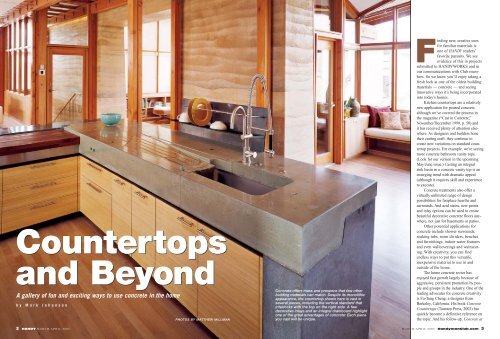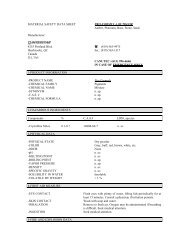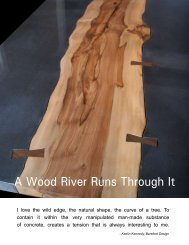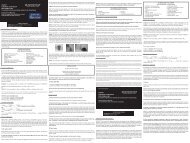Concrete Countertops
Concrete Countertops
Concrete Countertops
You also want an ePaper? Increase the reach of your titles
YUMPU automatically turns print PDFs into web optimized ePapers that Google loves.
<strong>Countertops</strong>and BeyondA gallery of fun and exciting ways to use concrete in the homeby Mark JohansonPHOTOS BY MATTHEW MILLMAN<strong>Concrete</strong> offers mass and presence that few otherbuilding materials can match. Despite its monolithicappearance, the countertop shown here is cast inseveral pieces, including the vertical standard thatinterlocks with the top on the right side. A fewdecorative inlays and an integral drainboard highlightone of the great advantages of concrete: Each pieceyou cast will be unique.Finding new, creative usesfor familiar materials isone of HANDY readers’favorite pursuits. We seeevidence of this in projectssubmitted to HANDYWORKS and inour communications with Club members.So we know you’ll enjoy taking afresh look at one of the oldest buildingmaterials — concrete — and seeinginnovative ways it’s being incorporatedinto today’s homes.Kitchen countertops are a relativelynew application for poured concrete,although we’ve covered the process inthe magazine (“Cast in <strong>Concrete</strong>,”November/December 1999, p. 50) andit has received plenty of attention elsewhere.As designers and builders honetheir casting craft, they continue tocreate new variations on standard countertopprojects. For example, we’re seeingmore concrete bathroom vanity tops.(Look for our version in the upcomingMay/June issue.) Casting an integralsink basin in a concrete vanity top is anemerging trend with dramatic appeal(although it requires skill and experienceto execute).<strong>Concrete</strong> treatments also offer avirtually unlimited range of designpossibilities for fireplace hearths andsurrounds. And acid stains, new paintsand inlay options can be used to createbeautiful decorative concrete floors anywhere,not just for basements or patios.Other potential applications forconcrete include shower surrounds,soaking tubs, room dividers, benchesand furnishings, indoor water featuresand even wallcoverings and wainscoting.With creativity, you can findendless ways to put this versatile,inexpensive material to use in andoutside of the home.The home concrete sector hasenjoyed fast growth largely because ofaggressive, persistent promotion by peopleand groups in the industry. One of theleading advocates for concrete creativityis Fu-Tung Cheng, a designer fromBerkeley, California. His book <strong>Concrete</strong><strong>Countertops</strong> (Taunton Press, 2002) hasquickly become a definitive reference onthe topic. And his follow-up, <strong>Concrete</strong> at2 HANDY MARCH/APRIL 2005 MARCH/APRIL 2005 HandymanClub.com 3
Skillfully combining concrete textures and colors creates an effect that is rich and dramatic. The master bath area abovedisplays a terrazzo-style floor embedded with troweled-in beach glass, turquoise and mother-of-pearl. The curb andsoaking tub are also cast concrete; the curb has a steel-trowel finish, and the tub and walls are stamped. Adding warmwood tones, such as the teak duckboards and bench above, enhances the beauty of both the concrete and the wood.Home (Taunton Press, 2005) reveals anew gallery of applications for residentialconcrete.such as Quikrete 5000 is a reliable choice.Admixtures — A host of accelerators,decelerators, air entrainers, plasticizersand more can lend concrete specificproperties. But these products are difficultto locate for home use and shouldbe used judiciously. Most fabricatorsagree that a water reducer is the mostvaluable admixture. It allows you to useless water while attaining good workability.Less water means less shrinkagein the form and stronger concrete.Pigments — Most concrete is coloredwith powdered or waterborne pigments,not dyes. Building centers stock a coupleof colors (usually black and brickred), but if you go to a concrete supplieryou’ll likely find at least 60 colors tochoose from. Designers often use differentconcrete colors and finishing techniquessuch as acid washing to give aproject depth and interest.Inlays — Small decorative objects suchas coins and seashells can be inlaid intoconcrete to give it a personal touch.Some objects can be set (or glued) intothe form before pouring; othersshould be embedded after the concretestarts to set up.To cast this colorful floor, Cheng’s design team added pigment to the concretemix and then applied an acid-wash treatment about a month later (see“<strong>Concrete</strong> Conversion,” July/August 2004, p. 20). The tropical tones complementthe bamboo drawer fronts and cabinet doors, and they blend nicely withthe natural slate wall tiles. Grinding and polishing a floor exposes some of theconcrete aggregate, giving it a more interesting, varied look and adding richness.The best tool for grinding and polishing a floor is a walk-behind grinderwith a planetary drive operating system. These tools can be used wet or dryand are available at selected rental centers.Designing your projectThe number and types of options availablewhen designing a concrete projectcan be bewildering. Besides decidingwhat to make, you’ll need to choosewhether to cast it in place or in a shop.Casting objects in a shop or garage ispreferable for ease of cleanup andventilation. But concrete is heavy — a1-1/2-in.-thick countertop weighs about20 pounds a square foot. Most professionalsprefer to cast in their shops butwon’t transport or install projects largerthan about 3 x 7 ft. Anything bigger isusually made in smaller sections thatare joined on-site.Other options you’ll need toconsider include:Type of concrete — You can blend yourown from portland cement, sand, aggregatesand water; use premixed bags; orhave ready-mix delivered to the pouringsite. If you’re using bags (the easiestoption), a 5,000-PSI, high/early mixtureThis concrete vanity was cast in twointerlocking parts. Although interestingand beautiful, it is not for beginners.Like any other medium, concreterequires experience and skill toyield pleasing results. Try startingwith smaller casting and finishingprojects (see “Cast Away,” May/June2003, p. 46) and work your way up tomore ambitious undertakings.Like horizontal castings, vertical projectscan be cast in place or cast offsiteand installed. This divider wallwas cast off-site and installed with thecabinets and counters it is integratedinto. If you look closely, you can see asmall seam in the middle of the wall,running at a slight angle. The anglemakes the seam less noticeable andless susceptible to directional stress.Creative concrete designers areconstantly looking for new objectsto inset, new colors and textures tocast and new applications for thematerial. Here a circulating waterfallis cast into the top of a 22-ft.-longinterior wall.The fireplace is a natural area to shape with concrete. You can use it to cast ahearth, mantel or surround — or all three. If you choose to make adjoining partsfrom concrete, incorporating complementary differences will make the designmore interesting. For example, in the fireplace above, the hearth and surroundfeature different pigments and finishing techniques. The hearth has a smooth,ground finish typical of a countertop or floor, whereas the surround is less polished— voids and other irregularities are left unfilled to increase visual interest.4 HANDY MARCH/APRIL 2005 MARCH/APRIL 2005 HandymanClub.com 5
Products and informationWhen we’ve published information aboutconcrete casting projects in the past,we’ve had difficulty helping membersfind sources for the necessary products.Most concrete materials suppliers sellonly to contractors and in volumes thatfar exceed the amounts of pigments,admixture or reinforcement fibers neededfor even a major kitchen countertop project.But as the interest in DIY concretework has grown, mail-order and Internetbasedcompanies have begun offeringThis highly polished raised slab elevates a woodstove while blending nicely with the buffed concretefloor below. For maximum sheen, concreteis ground and polished with a series of padsstarting at 50 grit and running as fine as 1,500grit. For safety, any change in elevation shouldbe at least a 4-in. difference.Form material — For slab-type homecasting projects, white melamine-coatedmedium-density fiberboard makes suitableforms that require no release agentand impart a very smooth surface onthe finished project.Whatever your design preferences, it’s<strong>Concrete</strong> Vanity TopInspired by the new and appealing uses for concrete that have been developed,we took a stab at creating with concrete ourselves. With the input of noteddesigner Fu-Tung Cheng and his associate Jeff Osteen, we designed and casta unique concrete vanity top here at the HANDY workshop. Then we built ano-weld metalvanity base to gowith it. Bothprojects weresurprisingly easyand they turnedout great. Watchfor them in theHandy Projectsand Metalshopdepartments ofyour May/June2005 issue ofHANDY. — MJbest to gather as much information as possibleand avoid getting carried away withtoo many fancy options. As Cheng writesin <strong>Concrete</strong> at Home, “Though there areno limits to the imaginative combinationsof the practical and the aesthetic, applyinga philosophy of restraint is a good idea.”PHOTO BY DAN CARY“Though there are no limits tothe imaginative combinationsof the practical and theaesthetic, applying aphilosophy of restraintis a good idea.”— Fu-Tung Cheng,from <strong>Concrete</strong> at Homematerials such as water reducer andmold-making urethanes in consumer-sizequantities and even kits.Fu-Tung Cheng’s design firm, ChengDesign, operates an Internet site calledThe <strong>Concrete</strong> Exchange (see SOURCESONLINE) that markets a full range ofproducts and kits for DIYers and tradespeople.The site includes a useful projectestimator that calculates how much materialyour project will require. Anothergood source for information and materialsis The <strong>Concrete</strong> Network Web site,which includes a concrete calculator, adecorative-concrete photo gallery, acontractor locator and more. All images by photographer MatthewMillman are reprinted from <strong>Concrete</strong>at Home courtesy of Taunton Press.For online information, go to www.HandymanClub.comand click on SOURCES ONLINE.Cheng Design (The <strong>Concrete</strong> Exchange)(510) 849-3272e-mail: products@chengdesign.comThe <strong>Concrete</strong> Network,www.concretenetwork.com6 HANDY MARCH/APRIL 2005



![View Project Profile [PDF] - CHENG Concrete Countertops](https://img.yumpu.com/44922980/1/190x245/view-project-profile-pdf-cheng-concrete-countertops.jpg?quality=85)
![View Project Profile [PDF] - CHENG Concrete Countertops](https://img.yumpu.com/43872326/1/190x245/view-project-profile-pdf-cheng-concrete-countertops.jpg?quality=85)
![View Project Profile [PDF] - CHENG Concrete Countertops](https://img.yumpu.com/36048443/1/190x245/view-project-profile-pdf-cheng-concrete-countertops.jpg?quality=85)




![View Project Profile [PDF] - Concrete Exchange](https://img.yumpu.com/29011002/1/190x245/view-project-profile-pdf-concrete-exchange.jpg?quality=85)
![View Project Profile [PDF] - CHENG Concrete Countertops](https://img.yumpu.com/23198167/1/190x245/view-project-profile-pdf-cheng-concrete-countertops.jpg?quality=85)
